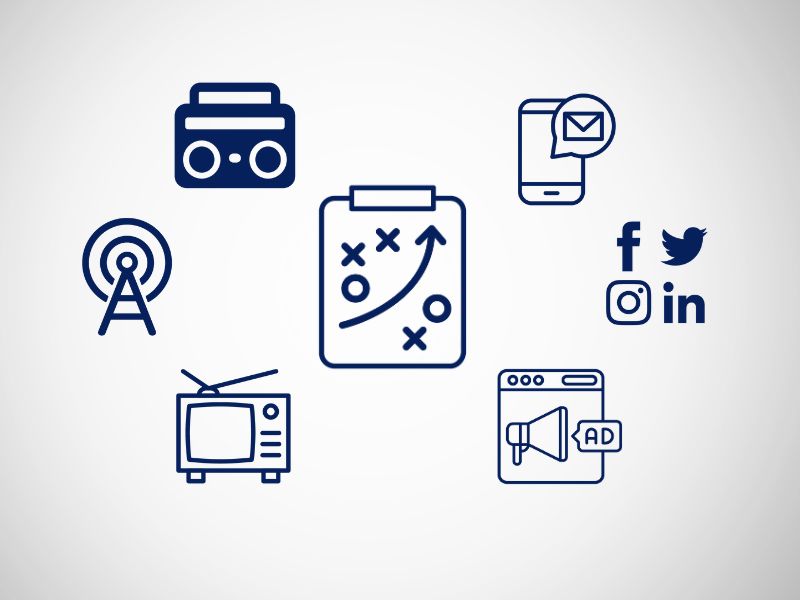
The State of Digital Advertising
.jpg)
There are many different types of digital advertising strategies, each designed to help advertisers achieve specific goals. Some lead users to a website, others encourage immediate purchases, and most are strategically served based on a user’s profile, interests, or demographics. Digital advertising is highly valued because it enables brands to precisely target customers and influence purchase decisions when it matters most. According to Basis Technologies' media trends report released January 2025, digital advertising will account for over 80% of total ad spend in the U.S. in 2025, making it the dominant force in marketing strategies.
The Most Common Types of Digital Advertising in 2025
Digital advertising means delivering promotional content to users through various online and digital channels. This form of advertising leverages the digital space to reach a broad audience, targeting users based on their interests, behaviors, and demographics. Digital advertising is highly effective due to its ability to deliver measurable results and precise targeting and data driven capabitlites, making it a key part of modern marketing strategies.
Here are the top 4 types of digital marketing strategies, according to the most recent state of digital marketing report:
1. Search Engine Marketing (SEM)
Search Engine Marketing (SEM) is an essential way to reach consumers actively looking for a product or service. Google remains the leader, with more than 99,000 queries processed each second, and 8.5 billion Google searches made every day, and is preferred by 80% of users compared to Yahoo and Bing. The total search engine market share of Google is 90.01%.

Within SEM, there are two primary strategies: Search Engine Optimization (SEO) and Pay-Per-Click (PPC) Advertising.
- SEO involves optimizing content, keywords, and website structure to improve organic search rankings, driving free traffic over time.
- PPC ensures advertisers only pay when users click on their ads, making it an efficient way to maximize budget by targeting engaged consumers.
2. Display, Video, and Audio
Display advertising relies on images and text to attract the user’s attention, and online follows suit- using shorter video content displayed on websites to attract users’ attention.
Digital Ads are placed on specific websites that match the demographics and psychographics of the desired target audience. Online video ads can run on websites alongside display ads, or prior to videos in a more video centric environment. Static banner display ads are the most common, but advertisers also have the option to create animated, video, and interactive ads to capture more attention in the cluttered digital environment.

CTV (Connected TV) and OTT (Over-the-Top) Advertising is now more prevalent than ever and allow advertisers an opportunity to run commercial length and quality ads to a digital viewer. CTV is experiencing massive growth, as streaming video ad spend is projected to increase by 15.8% in 2025 and grow 10% annually through 2027. These ads allow brands to deliver high-quality commercials to digital viewers on smart TVs, mobile devices, and tablets.
Digital Audio Advertising is also surging, with platforms like Spotify, Apple Music, and podcasts leading the way. As of 2025, U.S. adults are spending over four hours per day consuming digital audio and as of recent, time spent on digital audio has surpassed traditional radio, reversing trends from just two years ago, making it a valuable space for advertisers looking to engage audiences in a non-intrusive, immersive format.
3. Social Media Advertising
Social media platforms continue to dominate the digital landscape, with U.S. users spending an average of 2 hours and 23 minutes per day on platforms like Facebook, Instagram, TikTok, LinkedIn, and X (formerly Twitter). It’s no coincidence that advertisers are increasing budget allocations to these channels. Dollars go where consumers’ eyeballs are, and social media ads are relatively low in cost, so companies can efficiently target their customers and track results of how the campaign performed.

- Facebook still lead with over 3 billion monthly active users, while YouTube is close behind with 2.5 billion monthly active users.
- Retail social commerce sales are projected to surpass $100 billion in 2026, as TikTok Shop and Meta’s e-commerce partnerships make it easier than ever to shop directly from social feeds.
- The rise of micro-influencers (those with fewer than 10K followers) is making influencer marketing more effective, as their content is perceived as more authentic and trustworthy than traditional celebrity endorsements.
4. Email Marketing
You may feel that email is becoming a dinosaur. A relic of the early digital age. But it’s not so. And despite the rise of social media and instant messaging, email remains one of the most cost-effective digital marketing channels.
- The global email marketing industry is expected to grow at a steady rate through 2026.
- 50% of people said they buy from a marketing email at least once a month.
- Businesses see an average ROI of $36 for every dollar spent. Some industries do even better, with a $45 ROI for every dollar spent by retail, ecommerce, and consumer goods businesses, making it one of the highest-performing channels available.
To maximize email marketing success, brands need to focus on:
- Building qualified subscriber lists
- Personalized and engaging email content
- Automation tools to improve efficiency and audience segmentation

Digital Ad Spending Continues to Rise
Digital advertising is dominating marketing budgets in 2025, with total U.S. ad spending expected to reach $452 billion by 2028. This growth is driven by the increasing effectiveness and success of digital advertising strategies. Digital ad spending will grow by 12.5% in 2025 alone, with social media, CTV, and retail media leading the way.
The next time you see a digital ad, think about how and why it targeted you. Chances are, AI-driven insights, behavioral data, and strategic ad placements played a role. As brands continue to invest in AI, personalization, and omnichannel strategies, digital advertising in 2025 will be more precise, engaging, and data-driven than ever before. These data-driven capabilities will help advertisers optimize marketing campaigns for maximum impact, leveraging the best digital advertising practices to stay ahead of the competition.
Is your business keeping up with these trends? If not, now is the time to adjust your digital advertising strategy to stay ahead of the competition.



.jpg)
